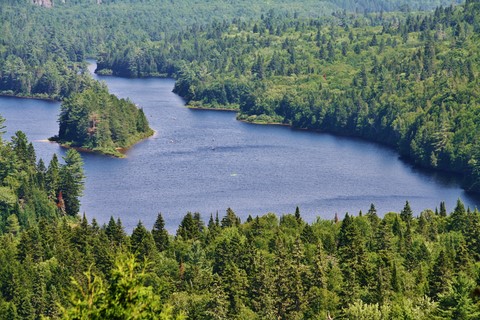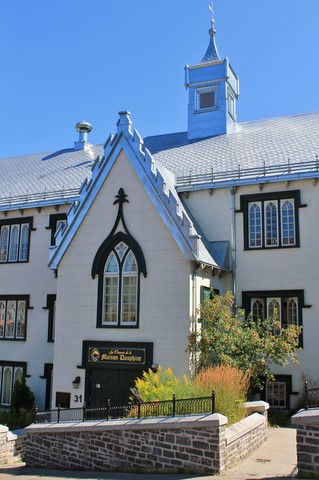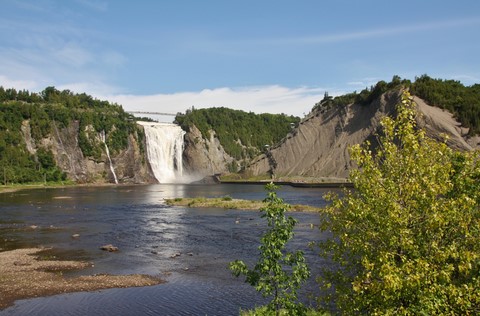Quebec
You can click on pictures to enlarge them
Montreal
Thriving, open and cosmopolitan cultural metropolis, you feel good there from the first moments, and you understand why it is appreciated by so many expats, notably Europeans. Besides, its influences from the Old Continent are maintained. It combines successfully tradition and modernity, as well as both European and North American cultures.
We stayed in a private home in a colossal Victorian building with a wealthy and old-fashioned charm located in the Westmount district (photo), more specifically in Sherbrooke Street. Very long, it crosses the city from east to west, and displays many buildings in the same style – or in other styles that are as much remarkable – for our viewing pleasure. We walked along a great part of it on our first day. We notably lingered in the surroundings of the Museum of Fine Arts, founded in 1860, around which works of street-art and above all an imposing Amerindian totem were exhibited.
Then, we headed for the City Center, taking the long Rue Saint-Catherine that is the main street. There, the architecture shows a disconcerting mix of old times and modern times that makes all its diversity. Shops – notably fashion boutiques – and art galleries are numerous there, as well as bars and restaurants. It also includes the arts and entertainment districts. Finally, it also covers the famous underground city, impressive 30 kilometers network of corridors where you come to get shelter from the cold and have a good time during rough winter days.
After we passed close to one of the gates of Chinatown to admire it, we carried on with Old Montreal, historic district of the city founded in the 17th century. Even if it did not escaped fires through decades, some period buildings still remain, others were restored. Some sections of paved streets were also preserved. Its promenades and its squares are very pleasant, notably the Place d’Armes, in front of which the Notre-Dame Basilica, built in the 19th century in Gothic Revival style, rises majestically. It is a must-visit, because the interior is simply sumptuous. The architecture of its wood-paneled polychrome decoration is extremely refined, with the technique of gold foil gilding. It is the most beautiful interior decoration of a religious building we have ever admired. Its presbytery, the Saint-Sulpice Old Seminary, was founded in the late 17th century in Palatial style. Near the Old Port promenade, the Notre-Dame-de-Bonsecours Chapel is the oldest stone church in town (late 18th century). The Marguerite Bourgeoys Museum is attached to it. As the name suggests, it is dedicated to the founder of the Notre-Dame-de-Montréal Congregation. Then, we climbed to the top of the Clock Tower that overlooks a part of Old Port, which was modernized over the years to become a wide entertainment area. It also offers an unrestricted view of the Jacques Cartier Bridge across the Saint-Lawrence River.
We made a short stop in Griffintown district, west of Old Montreal, just to visit the amazing Darling Foundry, old foundry founded in the 19th century converted into a wide art gallery where temporary exhibitions take place. Creative workshops are available to artists. We ignored that, but access is free on Thursday, so we were able to enjoy it.
In the evening, we went to immerse ourselves in the young and festive atmosphere of the Latin District, much appreciated by students and prized as well for its cultural life. The «À nous la rue» Festival was taking place there, and we attended a great show - that reminded us a giants’ parade - on the theme of science fiction, with notably an outsized E.T. articulated by various artists.
Given that the second day was dedicated to Mauricie Region National Park, we carried on the visit on Montreal the third day, relaxing in Mount Royal Park, real green lung in the city. Designed by the architect Frederick Law Olmsted to whom the famous Central Park in Manhattan is owed, it draws walkers, hikers and cyclists in summer, and skiers and skaters in winter. It also includes two cemeteries. From Sherbrooke Street, you get access there by a series of stairs on steep slopes. Once you arrived, the panorama opens to offer an unrestricted view of the skyline and the majestic Saint-Lawrence River beyond, thanks to two ideally placed panoramic viewpoints. Then, we left for Ottawa in the early afternoon.
On the last day of that unforgettable trip, we went to Jean-Drapeau Park, which extends over Saint-Helen Island and Our-Lady Island nearby. From its greenery appear the imposing outlines of the 80 meters in diameter Biosphere that you can see from the city center. Made of numerous metal triangles, it was built for the Expo 1967 and houses the Museum of Water and Environment. The Formula 1 Grand Prix takes place there, as well as very varied events. Finally, a rowing basin was put up on the occasion of the 1976 Olympic Games.
Mauricie Region
Region made of lakes, forests and mountains, it is the ideal place to commune with nature. You can revel in its wide open or immerse yourself with its silence in long moments of contemplation, to observe wildlife and plant life. But you can also be tempted by the various activities its setting allows: hiking, horse trek, biking, water sports… while enjoying those beautiful landscapes.
On the second day of our trip, we left Montreal to reach the Mauricie Region National Park (photo). It is composed of hardwood and coniferous forests interspersed with lakes in slightly undulating scenery. From the first kilometers of a scenic road – part of which runs along Wapizagonke Lake – we were lucky to see a young brown bear cross in front of us. We rented canoes to cross lakes and watercourses in the heart of a wide coniferous forest. Then, we let our boats on the shore to start a long hike in an idyllic setting, which main attraction is the spectacular Waber Fall. There, we could have a swim, bask while sitting on rocks with our feet in the water, or even stand under the thinner falls to get sprayed and enjoy the coolness. The good mood between hikers was contagious. Then, we found a wooden panoramic viewpoint a little further that offered a bird’s eye view on a breathtaking panorama. The lake’s deep blue matched with the conifers’ soft green. The place tempted to sweetness and dreamlike. We had the feeling we were all alone in the world. The place and the moment were magical. That is where we attended with happiness to our couple of friends’ marriage proposal. That place will remain forever related to that event in our minds.
Ideally located between Montreal and Quebec City, Trois-Rivières, region capital, was founded in 1634. Moreover, it enjoys a privileged location on the banks of the Saint-Lawrence River. For all those reasons, river traffic and maritime industry are significant and play a large part in the city’s prosperity. Nevertheless, culture is not forgotten: indeed, it was named «Cultural Capital of Canada» in 2009. Its center is not extended but it is beautiful, and the architecture is rich and varied. Taking a walk there is pleasant, as well as along the banks of the river. A complex notably houses the Quebec Museum of Popular Culture and the Old Prison, built in the early 19th century in Palladian style, which can be visited. The Historic Center of Paper Industry stands in a historic building and deals with the exploitation of boreal forest in Quebec.
We crossed the city to reach Mauricie Region National Park on the second day, but we did not stop there, for the road was long. And above all, a stop was planned during our return to Canada after our eleven days American interlude. Moreover, we stopped there once again on the eve of our departure as we headed for Montreal from Quebec City. There, we visited the Chez Dany sap house, very charming and typical wooden house. The interior decoration, with large solid wood tables covered with checkered red and white gingham tablecloths and old wood-burning stoves, tempted to nostalgia. We had the warmest welcome, the whole in a homely and good-natured atmosphere. They taught us the different steps of maple syrup production and showed us the tools and machines used. It was very enriching, and we spent a memorable moment immersing ourselves in the Quebec culture and tradition.
Quebec City
Founded in 1608, it is the only fortified city north of Mexico. Charming town with an entrancing beauty, it makes a big impression on each visitor. The charm works on every street corner, as well in Lower Town with its paved streets, its stairs, its very typical small squares and its gardens, as in Upper Town with the must-visit Frontenac Castle which colossal outlines with a wealthy and old-fashioned charm proudly overlooks the rest of the city and the Saint-Lawrence River. It is the idealized image of the town, even of Quebec in general. We went there after our American interlude, and we spent a whole day and an evening there, which allowed us to visit the old city.
The Old Quebec is quite rightly a UNESCO World Heritage classified site. In Upper Town (photo), the Frontenac Castle rises on Cap Diamant, eastern part of the Quebec Hill. Luxury hotel that includes 611 rooms and various restaurants and shops, it is the iconic building of the city. It was built in the late 19th century with cut stone and red brick, the whole propped up by a steel frame. Asymmetric, it has five wings, a central tower, various turrets and an inner courtyard. Its sloping roofs with mansards include high chimneys in places. Admission is free and we were able to admire its sumptuous interior decoration. The National Historic Site of Saint-Louis Forts and Châteaux offers guided tours that allows you to discover its first floor. At its foot the Dufferin Terrace extends: very wide and made of wooden boards, it has bandstands with and old-fashioned charm and a refined architecture. It is prolonged by the Governors’ Promenade: mainly made of stairs, it runs close to the Citadel to reach the Plains of Abraham, scene of the French defeat against the English in 1759. They are located on Battlefields Park, a more than 100 hectares haven of greenery. The Citadel was built by the English in the first half of the 19th century on the top of Cap Diamant, in style influenced by Vauban (star-shaped fortifications). Now, it houses the Residence of the Governor General of Canada and the Royal Museum of the 22nd Regiment. Its terraces offer a breathtaking view on the city and the Saint-Lawrence River. On the other side of the Frontenac Castle and the Dufferin Terrace stand many remarkable sites, notably the Fort Museum and the North American French Museum. Places of worship are not forgotten with the Notre-Dame-de-Québec Basilica-Cathedral, reconstructed many times through centuries, and which history is much tormented. The Holy-Trinity Cathedral proudly displays its Palladian style. It is the first Anglican cathedral out of the United-Kingdom. The Monastery of Ursulines is located in an architectural ensemble that also includes a chapel and a museum.
The Fortifications of Quebec National Historic Site teaches you much about that remarkable defense system that surrounds the old town, and which main elements are Saint-Jean Gate and Kent Gate – that are located in front of the Chapel of the Jesuits and the Maison Dauphine – and Saint-Louis Gate.
The Rue de Saint-Jean is one of the most picturesque in the district: restaurants, bars and shops are numerous. Its beautiful stone façades are embellished by colored paneling that give it a certain charm and an undeniable character. At night, it becomes a pedestrian street. Street performances take place there, terraces of restaurants fill up, the whole in a good-natured atmosphere where young and old alike mix without distinction.
There are many ways to reach Lower Town from Upper Town, but the most picturesque is going downstairs or using the funicular from the Dufferin Terrace to the Petit-Champlain area, old fishermen district renovated and filled with charm with its restaurants and its local craft shops. The Place Royale seems to have remained intact throughout the years. Former market square, it is surrounded by typical houses from the 17th and the 18th century. A museum is dedicated to it. Nearby rises the Notre-Dame-des-Victoires Church. Dating from the late 17th century, it was since then reconstructed and renovated. The Fresque des Québécois, trompe-l’œil painting, has amazing dimensions. Famous characters that played an important role in the province are represented. Smaller, the Fresque du Petit-Champlain is nevertheless a must-see. The Rue du Trésor welcomes numerous artists who show a wide choice of paintings, watercolors, engraving, drawings and silkscreen prints.
If you walk along the Saint-Lawrence River, you reach the Old Port, where the Naval Museum of Quebec traces the military events that took place on the river. Nearby stands the Agora, outdoor amphitheater where summer shows take place. Both are located on the junction with the Louise Basin. The latter welcomes a picturesque covered market that offers many local products. On the leisure port, a pleasant wood boards promenade runs along the marina. The Espace 400e offers temporary exhibitions and varied events. Nearby, the Rue sous le Cap is an amazing ensemble of terrace-footbridges above our heads that connect pretty colored houses to sheds.
Quebec City is part of our favorite cities. To have direct access to the section, click here
Quebec City Surroundings & Tadoussac
As we left Quebec City to reach Montreal on the penultimate day of our tip, we went to admire the Montmorency Falls Park (photo). The latter is higher than Niagara Falls, but less powerful and less impressive. Nevertheless, it offers a breathtaking spectacle, especially when you observe it from the overhanging footbridge. You can have access there by taking the stairs that include panoramic viewpoints or by taking the cable car. For thrill-seekers, a double zip-line is put up just above. In winter, there are times when the drizzle freezes and forms a sugar loaf. The place is located in a haven on greenery and is well wooded, which allows walks and hikes. Picnic areas are at the disposal of visitors. The Montmorency Manor, built in 1780, was destroyed by fire and reconstructed accurately to the original architectural style in 1994. In addition to a restaurant terrace and a gift shop, it includes a center dedicated to the history of the site.
Then, we left to Montreal, taking a section of the King’s Road, which was the first carriage road built in New France from the 17th century to connect Quebec City, Trois-Rivières and Montreal. It runs along the Saint-Lawrence River through picturesque villages and small towns. It has specific blue road signs with a crown. We went notably through Cap-Santé, classified among the most beautiful villages in Quebec. The Cap-Santé Church and its presbytery are remarkable. We made a stop in Portneuf, charming village founded in the 17th century on the banks of the Saint-Lawrence River, at the mouth of the Portneuf River. It includes a water sports recreational park and an ornithological observation site. Moreover, we were lucky to see a condor as soon as we got out of the car, which is apparently very rare according to a local who said that he came regularly there in the hope of observing some of them… every time in vain!!! Other attractions are the Church of Notre-Dame-des-Sept-Douleurs, Hale Manor and above it all the Calvary of the Notre-Dame-de-Portneuf Cemetery, listed as a Historic Monument.
On our second day in Quebec City, we went on a trip to Tadoussac for a whale watching cruise. Indeed, it is the ideal place for that kind of activity: located in a bay in the mouth of the Saguenay Fjord that flows into the Saint-Lawrence Estuary, it is rich in plankton and therefore attracts many cetaceans. The village itself is splendid, and is part of the most beautiful in Quebec. The softness of the sandy bay and the green wooded hills contrasts with the hardness of the gray ragged cliffs of the fjord.
The cruise was memorable, embellished by the comments of a guide with contagious passion and enthusiasm. We were able to admire many rorquals and belugas. In the background, we could see in places nice colored wooden houses in their green setting, small sandy beaches and small ports filled with charm.
Published on December, 15th 2018







